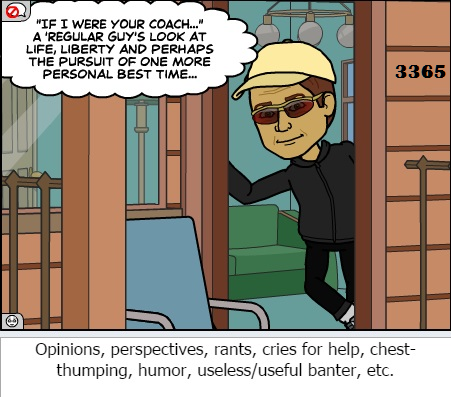The casual observer would think the last weeks leading into a target race is easy for a coach. Not really. There's only a small amount of physical preparation leading in - more often than not it's ensuring not too much is done. But the mental work - the calming of fears and genteel reminders to stay as close as possible to the happy place during the days before the race - still goes on. And of course there's race day, a time where I've spent the past couple of years at our local marathon at an unofficial, er, "Colorado Kool-Aid" station around the sixteenth mile of the course.
For me, it's a little tomfoolery and giving back to the individual runners outside of my other roles as coach, course measurer, chronicler of things-going-on, creator of curriculum...and curmudgeon. Runners who have lived slightly over two decades who slow up at my place on the course, about a tenth of a mile before a genuine event-sponsored aid station, can get a little bit of Colorado Kool-Aid. It's a small amount of post-race refreshment, which comes about ten miles sooner than the first-time event participant expects. Returnees have greeted me with, "oh, it's YOU again..."
Right before they take the small offering of Rocky Mountain (or Milwaukee, or St. Louis) goodness. Or they continue on to the official aid station and take their spring water (or whatever swill is being offered) there.
But I digress.
I've waited at other points for my athletes, watched them come through the finish, but I prefer to stay at arms' length or farther and let the time after the finish be for the racer and their family. Do I want to know the "how well" question? Absolutely. But in most cases race day is for the racer alone. The athlete, should they feel the need to pass along the details, will. When they feel like it. When my athletes have run well and had a great day I'm elated and vindicated. When they have a bad day I want to curl up on the couch and not talk to anybody for a couple of days....which I cannot do because I have training and work and family matters which require my attention. Just like my athletes.
So I can only imagine what the New York Road Runners' marathon coach, a fellow by the name of John Honerkamp, was feeling like this last weekend. He works to train about 900 runners in a 20 week program which focuses on the New York City Marathon. E-mail is his modality, which for me isn't the most perfect, but when your clientele is spread across 80 different countries you do what you must. Personally, I'd love to see the algorithm he's using; if it personalizes what I've perceived as the over-generalization of distance training plans, then more power to him.
There's a difference between a coach and a seller of workout books. That difference comes when the athlete needs a guy (or gal) who isn't just pushing workouts, but someone who really gives a damn about the individual athlete's well-being. Taking the time to listen when an athlete's family member, or the athlete, is sick, injured, or worse...well, that can take a lot out of you. It's something a book or an application will never be able to do. Running is a social activity. The ability to interact with each other - peer-to-peer or athlete-to-coach has a value which far exceeds any $25 book or $200 twenty-week cycle.
If you're racing in the near future, I wish you the best of success.


No comments:
Post a Comment